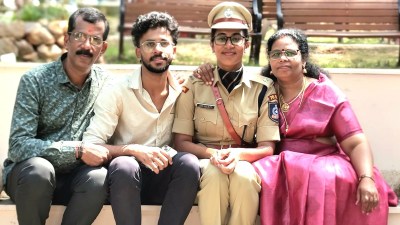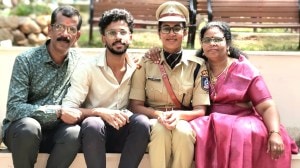Chola emperors Rajaraja I and Rajendra Chola I will soon have statues erected in honour of their rich legacy. Recalling the glorious contribution of the 10th-century Chola empire in South India, Prime Minister Narendra Modi recently said that the statues “would serve as modern pillars of India’s historical consciousness” and hailed the two rulers as “synonymous with India’s identity and pride”.
The Chola empire is known to have reached its peak under Rajaraja I and his son and successor Rajendra Chola I. The doyen of South Indian history, Nilakanta Sastri, has written in his book The Cholas (1955) that under Rajaraja I and his successors, the Chola empire had reached the capacity of ‘Byzantine royalty’, “with its numerous palaces, officials and ceremonials and its majestic display of the concentrated resources of an extensive empire”.
Story continues below this ad
Rajaraja I was born to King Parantaka II in 947 CE. Records from copper plate inscriptions have revealed that upon his birth, he was named Arulmozhivarman. Upon accession to the throne in 985 CE, he adopted the regnal title ‘Rajaraja’ or king of kings. At the time he came to power, Rajaraja I had inherited a tiny kingdom centred around the Thanjavur-Tiruchirapalli region that was still recovering from the disasters of the Rashtrakuta invasions.
Under the new king, though, imperial expansions of the Cholas took a whole new turn. Sastri noted in his book that the first military achievement of Rajaraja I’s reign was the campaign in the Kerala region. Under his rule, the Chola Empire expanded all along the eastern coast, up to Kalinga in the north. The Cholas soon gained the upper hand over the Pandyas, who were another great dynasty in the Tamil region at the time and one of their biggest rivals. Consequently, the Cholas emerged as the primary power in the northern and eastern parts of the Tamil country.
Yet another hallmark of the rule of Rajaraja I was the predominance of maritime trade. “Rajaraja Chola understood that domination of lucrative trade routes was a sure way to distinguish himself and his court from the other fragmented polities of the Tamil country,” writes public historian Anirudh Kanisetti in his book, Lords of the Deccan: Southern India from the Chalukyas to the Cholas (2022). He understood that their rival, the Cheras, who controlled the Malabar region, were welcoming traders from across the sea, especially from prosperous Fatimid Egypt.
Kanisetti, in his book, describes in vivid detail how the young Rajaraja I moved to seize the riches of the region by attacking the great port of Kandalur. Under his orders, what was possibly southern India’s largest collection of ships at the time was burned down. “Masts must have collapsed, teak wood cracked and slipped under the roiling waves, probably to the cheers of thousands of Chola soldiers as they ransacked the populace and held back weeping merchants at spear-point,” writes Kanisetti. “Rajaraja I had seized a colossal loot and established himself and the Cholas as one of the rising powers of the southern tip of the subcontinent. Trade would only be allowed to flow if merchants reached an accommodation with the Cholas, it seemed.”
Story continues below this ad
Over the next 10 years, Rajaraja I established himself as one of the most astute and sharp political leaders to have emerged in South India. He managed to take over all Pandya territories and then moved to Sri Lanka, where he ransacked several Buddhist Viharas and built Shiva temples in their place to establish the reign of the Cholas.
Sastri, in his book, mentions that by the end of his rule, the Chola kingdom had grown “ to be an extensive and well-knit empire efficiently organised and administered, rich in resources, possessed of a powerful standing army, well-tried and equal to the greatest enterprises.”
The Cholas under Rajendra Chola I
The personal abilities of Rajaraja I laid the foundation for the achievements of his son and successor, Rajendra Chola, also known as Rajendra the Great. Under the latter, the Chola empire attained its greatest glory and carried its arms beyond the seas.
Rajendra Chola had first assumed royal power in 1012 CE as his father’s co-regent, and later became king upon Rajaraja I’s death in 1014 CE. From his father, Rajendra had inherited an extensive empire comprising the whole of present-day Chennai and Andhra Pradesh and parts of Mysuru and Sri Lanka. He had benefited from a well-established, powerful bureaucracy, a strong army, and a flourishing trade system.
Story continues below this ad
Sastri in his book noted that “during the thirty-three years of his reign, Rajendra turned these initial advantages to the best possible use and succeeded in raising the Chola Empire to the position of the most extensive and most respected Hindu state of the time, and one which possessed though perhaps only for a time a not inconsiderable dominion over the Malay Peninsula and the Eastern Archipelago.”
The history of Rajendra’s reign, wrote Sastri, is largely the history of the extensive wars and conquests he undertook in the first half of his reign.
Rajendra became one of the only Indian monarchs to capture territory outside the Indian subcontinent. In 1025 CE, he sent a naval expedition to Indochina, the Malay Peninsula, and the Srivijaya Empire, which is present-day Indonesia. The expedition was aimed at controlling key trade routes in the Indian Ocean region, hitherto controlled by the Srivijaya Empire.
As noted by historian Herman Kulke in Nagapattinam to Suvarnadwipa: Reflections on the Chola Naval Expeditions to Southeast Asia (2010), a book he edited with two others, the Chola invasion of Srivijaya was a unique event in the history of India and “its otherwise peaceful relations with the states of Southeast Asia which had come under India’s strong cultural influence for about a millennium”.
Story continues below this ad
As per inscriptional records, after attacking Srivijaya, Rajendra I captured King Sangrama Vijayattunggavarman and looted treasures from the Buddhist empire, including the Vidhyadara Torana, the jewelled war gate of Srivijaya.
Rajendra Chola’s expansion into Southeast Asia was crucial in establishing trade and cultural links in the region. Chola art, for instance, travelled into large parts of Southeast Asia.
He is also credited with building the Chola capital at Gangaikondacholapuram (close to present-day Tiruchirapalli) to commemorate his victory over the Pala dynasty in present-day Bengal in 1025 CE. In his book, A History of South India, Sastri wrote that the name of the capital, meaning ‘the town of the Chola who took the Ganges’, was a statement to announce the emergence of the new royal power in South India.
Thereafter, he built a large Shiva temple, which continues to be revered profusely, and is at the centre of the Aadi Thiruvathirai festival, where PM Modi announced the installation of the great Chola emperor’s statue.
































